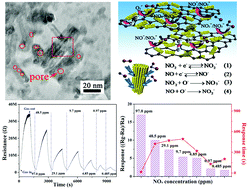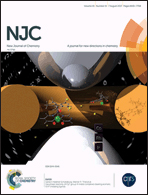An In2O3 nanorod-decorated reduced graphene oxide composite as a high-response NOx gas sensor at room temperature†
Abstract
A novel composite room temperature gas sensor based on an In2O3 nanorod-decorated reduced graphene oxide composite (In2O3 NR/rGO composite) was successfully synthesized via a facile reflux method. In this synthesis, In3+ and urea were adsorbed on GO through electrostatic interactions in a water solution. The subsequent reflux treatment led to the transformation of the In(OH)3 nanorods coated on GO and also to the reduction of graphene oxide. We demonstrate that the composite can detect NOx gas with a response of 1.45, a fast response time of 25.0 s for 97.0 ppm NOx and a low detection limit of 970 ppb at room temperature. Compared with the pure In2O3 NRs, the composite has a faster response within 30.0 s over the whole range of NOx concentration. The enhanced sensing properties are attributed to the synergy of the superior conductivity of rGO and the nanostructure of the In2O3 NR/rGO composite. The present strategy for combining various hydroxide and nanoscale building blocks into integrated 3D structures will open new opportunities for designing and synthesizing multifunctional composites.



 Please wait while we load your content...
Please wait while we load your content...